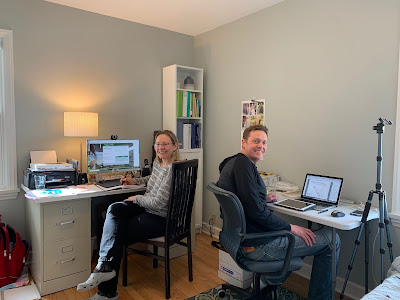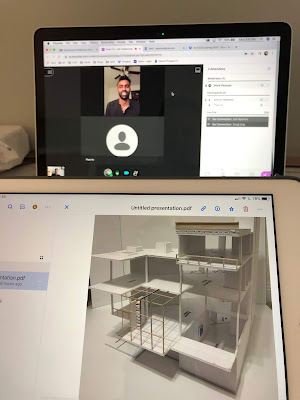So, are there any benefits to this online, remote teaching experiment? Mostly, I miss the face-to-face contact with my students. I miss sketching on trace paper, and having conversations about study models while holding a real object in my hand.
But maybe there are some positives to learn from all of this as well. So I am starting a simple pro’s and con’s list to remote studio instruction, to try to understand all of this.
PRO’s
No Commute!
I am not missing my hour and a half of driving each day. That is certainly one advantage of working from home. (Although I do miss seeing people) Several of my students have also echoed this same sentiment. One student mentioned that she could take more classes this summer because online course are more convenient for her and she doesn’t need to spend so much time diving to and from campus.
Accountability (Digital Desk Crits)
I have been doing a lot of one on one desk critique meetings remotely. These individual student appointments have been quite productive. In some ways these individual meetings have been more productive than in the studio. There seems to be a level of accountability involved in this. I think it is related to the formality of assigning meeting times. The students have nearly always had work uploaded in their directory to discuss for these meetings.
I assign a meeting time and students show up, prepared. I am still amazed by this!
In a traditional studio desk crit, that doesn’t always happen. I still have some students avoiding me by not scheduling meetings, but for the most part these have been very effective. This week, for example, I saw a number of final presentation graphics to critique. I rarely have students ready to do that in the face-to-face studio until the final deadline. I may try to incorporate some of this process into the FTF studios in small ways in the future.
 |
| Digital Desk Crit Markups |
 |
| Digital Desk Crit Markups |
 |
| Digital Desk Crit Markups |
 |
| Digital Desk Crit Markups |
One downside, though, is that everything is scheduled. There are no serendipitous conversations, or quick studio questions. Everything is a planned discussion with an online meeting time. This has lead to students being prepared, but I also miss the unplanned design conversations that occur organically in the studio. There is no way to replicate that.
.pdf assignment collection
The students have been submitting assignments to me as .pdf packets of work. I like having this digital record of the student work, and it gives me markup options for grading and giving feedback that are kind of nice. I enjoy having a digital record of the drawing markups that I create with students. I know exactly what I talked about with each student, each studio day, as a result of this process. And students get a digital packet back in return with redlines to reference as they develop their work. This process is slower than in the FTF studio, but there are advantages to it.
.pdf presentations
My remote studio has been forced away from the presentation board, to a curated slideshow for graphic presentations of their work. I suspect that this presentation format will also help their final review presentations. I suspect it will force the students to more carefully consider their verbal presentations, as they will need to curate (and really think about) the content and order of their slides.
I will know more about how effective this is been after next week.
Are we missing some graphic composition learning objectives, yes! But the overall graphic and verbal communication seems to be an improvement in this format.
No more throwing images on a board at the last minute without thinking about the story those images tell. (At least that is the hope!)
CON’s
I think there are a lot of deficiencies to teaching studio remotely, actually. I am luck that we were halfway through the term before this experiment began. I do not think remote studios are an adequate substitution for FTF design instruction, especially at the second year level.
Here are a few of the pedagogical challenges I have seen in the virtual design studio.
Creative Motivation
One of the beautiful aspects of a design studio is the creative energy. You have a bunch of creative people, working in close proximity to one another, all influencing each other creatively. A lot of learning happens in the studio when the instructor is not present. There is a kind of cross pollination of creative thinking and energy that occurs in a good design studio.
This is not always happening for students from home. A number of my current students have talked about how difficult it is to find motivation to produce creative work while in isolation. This is perhaps a design opportunity for my assignments to address in the future, but it seems nearly impossible to replicate the shared learning of a busy studio online.
Skills Gap
There always is a range of skills in my second year studio. Some students excel at some things, while other students struggle. This is expected in any classroom environment.
But the move to remote learning seems to have amplified this in some cases. I have noticed that the performance gap between the top students and those who struggle is being amplified. Some students are really struggling to manage working from home, while others have adjusted fairly seamlessly to all of this. External factors seem to be playing a large role in all of this. Perhaps that was always the case, but this era of COVID self-isolation seems to be revealing and exaggerating a number of structural cracks. I have seen this though the wide range of work in my studio. The weaker projects are noticeably worse in this format, and I am exhausting a tremendous amount of energy to keep some students moving forward.
3d Visualization + Design Development
Design development is always a challenge to teach in the second year studio. Students often get stuck at one level of design development, and miss opportunities to really improve their design work. One major challenge for younger architecture students is learning to develop their work 3-dimensionally. 3D visualization skills are always a major part (and challenge) of studio teaching at the second year level. Because of this, we usually make a lot of physical study models in my studio classes. I have come to believe that the making of physical, 3-dimensional, study models is the best way to teach students to “see” and understand their work.
Form, composition, scale, and spatial qualities of design seem to be best revealed to students through making objects with their hands.
This semester, when we moved to remote instruction, the studio seemed to get stuck in 2d world. Students keep showing me floor plans, even when I ask them to work in models. They keep drawing plans over and over, without always understanding the 3d implications of their drawings. Study models (and the 3d design development that goes with it) have been sluggish. Part of this is loosing access to the studio, with space to work and ample supplies. Some of the student shave had trouble getting model-making supplies.
Part of the problem may be that I have not transitioned expectations effectively. I need to learn how to teach in this format as well, and write assignments that give me the results I am looking for.
We have also lost access to our beloved site model. We spent several weeks of the semester making this tool, only to suddenly be forced to leave it behind. The study models I am seeing are less effective without context. It is hard to have conversations about the building’s relationship to its site in this format.
 |
| The site model, usually a key tool, sits in an empty studio. |
So the “getting stuck in 2d” problem is part workspace, part material availability, part motivation, and part instructional design.
But I think the real issue is 3d visualization skills. Some students really struggle with visualization, and online learning seems to amplify these deficiencies. Students have reverted back to what they are most comfortable with – drawing in plan. It is the easiest drawing. And you don’t have to build that time consuming model.
The problem is - I still don’t know what some of their design projects look like. One week before final reviews! I’m a little concerned about this.
A “first study” in a final review is never a good thing.





















